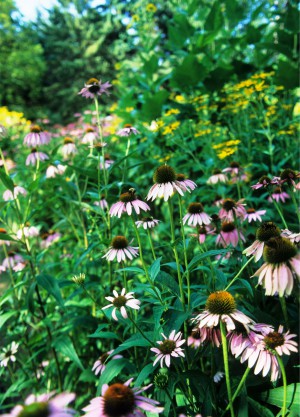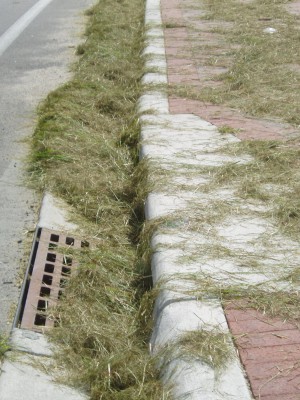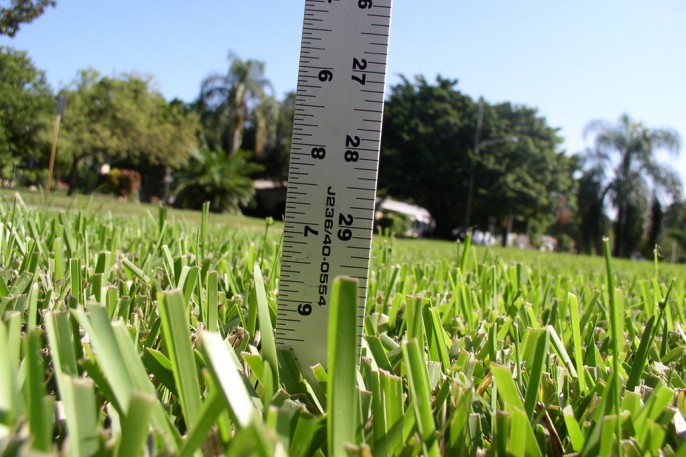Lawn and Garden Care
A “stormwater friendly” lawn is one that can absorb rainwater and does not harm local streams due to the over-application of chemicals. While many stormwater BMPs are superior to lawns in terms of a positive impact on water quality, a healthy lawn can be a great place for recreation and be part of an environmentally-friendly landscape. Similarly, a “stormwater friendly” garden is one that uses organic compost as fertilizer to amend soil and minimizes or eliminates the use of chemical applications. Reducing chemical applications and encouraging infiltration will help stabilize local water flows and also maintain natural nutrient levels in streams. Stormwater friendly lawns and gardens save money in terms of chemical application costs and can save time concerning upkeep when the lawn or garden is established.
Stormwater Friendly Garden

Native plants, such as these purple cone flowers, require less fertilizer and pesticides since they are well adapted to local conditions and pests.
Home gardens can contribute a considerable amount of nutrients and other pollution to streams and other water bodies if not cared for in a responsible way. This mainly applies to fertilizers and pesticides.
Fertilizers for the garden: Organic alternatives to chemical application include compost or manure. Compost is a free form of fertilizer and contains the many nutrients needed for your vegetables. These fertilizers should be applied directly before planting the vegetables to prevent runoff.
Pesticides- identify the pest, research your options: Many insects are harmless to people and play an important role in maintaining a healthy lawn or garden ecosystem. If there is a problem, however, identify the exact pest you have. Consult an expert, as there are many non-chemical alternatives to controlling pests. Pesticides can infiltrate into ground water, contaminate drinking supplies, and severely harm downstream ecosystems if applied incorrectly or unnecessarily.
Additionally, consider using conservation landscaping methods when working with your garden.
Stormwater Friendly Lawn
An estimated 6.1 million homeowners in the Chesapeake Bay Watershed manage and maintain their own lawns. Following the steps below will not only help protect local streams and rivers, but can result in direct and substantial cost savings to the homeowners.
Set mower height to 3 inches or higher: The taller grass slows the rate of runoff and will produce a deeper and denser root system. Denser roots will absorb more water, reducing lawn runoff and preventing erosion. Deeper roots have access to more water stored in the ground and can reduce irrigation need during droughts. Denser roots can also suppress weeds from growing up around them.
Retain grass clippings and chopped leaves on-site: A mulch-mower is ideal for retaining and spreading clippings on your lawn. The clippings decompose quickly, provide important nutrients for your lawn, and settle to create an organic layer on the soil that encourages stormwater infiltration. This technique can significantly reduce or eliminate the need and cost of nitrogen fertilizers.

By spreading grass clippings on your lawn, you can reduce the amount of fertilizer needed. It is important to keep clippings out of storm drains and the street. Image courtesy: Alachua County, FL
Keep clippings and chopped leaves out of streams, off the street, and out of storm drains: If mulching is not possible, bag the clippings and store them in a compost area where the organic material can be used as a fertilizer as a later date. Blowing them on to a street or into storm drains leads the clippings directly to local streams, where they decompose and act as major pollutants by increasing nitrogen to unsafe levels for fish and other aquatic life.
Fertilizers for lawn- do you need it? If so- what, where, when, and how much?: Many lawns do not need fertilizer, due to the soil fertility or by carrying out previously discussed practices. Using no fertilizer is ideal for the health of the bay, but if your lawn is thin or has bare spots, you should consider fertilizing it. A dense vegetated cover is the most “stormwater friendly” lawn.
- Test your soil or consult a local professional or certified applicator: There is no “one size fits all” when it comes to fertilizer. Needs vary drastically based on soil texture, pH levels, and nutrient levels. In fact, soil tests can reveal that lawns may be suffering from micronutrient deficiency, and standard chemical fertilizers may not alleviate the problem. Identifying these needs will reduce unnecessary applications, create a healthier lawn faster, and reduce long-term costs.
- Maximize the slow-release nitrogen in your fertilizer: Typically called “water insoluble nitrogen” or WIN on fertilizer bags, slow-release nitrogen limits nutrient runoff and exportation. This should be applied in the Spring, opposed to the Fall, to provide a steady source of nutrients throughout the growing season.
- If fertilizer is needed, apply less than 1 pound per 1000 square feet per application: Some instructions refer to pounds per season, not to be confused with application- as there are multiple applications per season.
- Start with low amounts or fewer applications: Your lawn may achieve its ideal coverage and growth with reduced rates, saving time and money.
- Apply only during the growing season, and check the weather: Wait until the grass begins growing in March to fertilize, and avoid fertilizing after October. Fertilizing during a lawn’s dormant season increases the risk of running off into streams or leaching into your water table because root systems are less active. Additionally, do not fertilize directly before a rain event, because most will wash off in stormwater runoff.
Do not fertilize or use pesticides with 15 to 20 feet of a stream, use riparian-specific herbicides if necessary: Keeping this distance will help keep chemicals out of the stream. Consider establishing a natural riparian buffer, instead.
Immediately sweep any granulated chemicals off hard surfaces and back onto your lawn: Your walkway, driveway, patio, or local road is often a quick route to drainage pipes that discharge into local streams.




